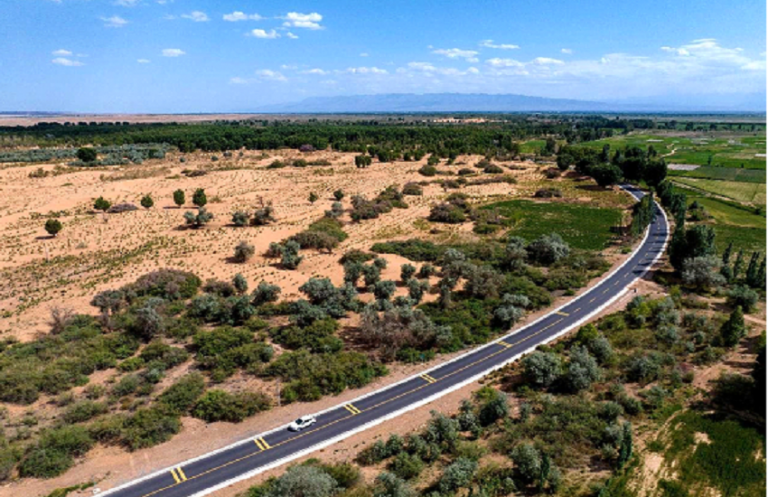
By Yin Shuanghong, A mix of yellow and blue creates green, and that’s also the case with China’s efforts to combat desertification. Thanks to the blue photovoltaic (PV) panels that block direct sunlight, reduce evaporation and lower wind velocity, as well as the moisturizing from the water used to clean the panels on a regular basis, a large portion of the yellow desertified land in northwest China is turning green, covered by lush vegetation.
However, the story is not that simple. The barbaric growth of grass on the desertified land would lower the power generation efficiency of the PV panels and even trigger fires. Therefore, sheep are raised there to consume the grass under the vast “blue sea” of PV panels.
Developing new energy, curbing desertification and increasing income for herdsmen, the “PV+sheep farming” model is a miniature of the Chinese wisdom in sand control. Desertification control is a protracted battle. To win the battle, it calls for both perseverance and wisdom.
In the repeated trial of strength with sand, Dengkou county in north China’s Inner Mongolia autonomous region has developed a successful approach to prevent sand with trees, fix sand with grass and restore soil with PV arrays, while Kekeya township in northwest China’s Xinjiang Uygur autonomous region is growing cash crops such as apples, nuts and dates in shelter forests.
It is exactly because of these effective models that China has achieved the historic transition from desert displacing human settlement to green oasis replacing desert. China has blazed a special path of desertification prevention and control that follows the rules of nature and suits China’s national reality and local conditions.
These models are effective because they suit local conditions. The characteristics and water resource capacities of desertified land vary from region to region. Even within the Kubuqi Desert, China’s seventh-largest desert, conditions differ. In the arid southern fringes of the desert, seeds of shrubs have been densely sowed by airplanes. On the northern edges, which have some water sources, arbor trees are planted as windbreaks. Along the cross-desert highways and rivers in the central part of the desert, shelter forests are grown. In the interdune lowlands and areas with shallow groundwater levels within the desert’s back-land, oases are nourished.
Only by proceeding from reality, applying a systematic thinking and developing desertification control models tailored to actual conditions, can new prospects of sand control unfold. The best lessons are always learned from practice. Having a review of the desertification control experience of China’s Three-North Shelterbelt Forest Program, one could find a series of “indigenous techniques,” all of which are the fruits of the people’s hard work and wisdom.
Straw grid, known as the Chinese “Rubik’s cube” for sand control, was exactly invented in the Tengger Desert in Zhongwei, northwest China’s Ningxia Hui autonomous region. Learning from practice and the masses – this is where the wellspring of innovation in desertification control lies.
At a desertification control and afforestation base in the Mu Us Desert, Shenmu, northwest China’s Shaanxi province, a young man named Zhang Zhili aspires to become “a pine tree standing tall in the desert.”
After graduating from university, the man, born in the 1990s, started working in afforestation, setting up a four-person research team focusing on microbiological studies. “If we succeed in cultivating edible mushrooms like red matsutake and penny bun under the forest, it could generate an additional income of 60,000 to 70,000 yuan ($8269-9647) per mu (667 square meters). This would encourage more people to invest in tree planting and afforestation,” Zhang noted.
From sand prevention to sand control, and to sand utilization – when desertification control harmoniously integrates with income expansion, and when new-generation practitioners apply novel concepts and technologies to “turn sand into gold,” the battle against desertification would gain a perpetuating, endogenous driving force.
Desertification is a major global ecological issue that impacts human survival and development. China is one of the countries most severely affected by desertification worldwide. China has persisted in focusing on sand prevention and control, continuously innovating and refining desertification control models, so as to contribute more Chinese wisdom and solutions to global efforts in combating desertification.










